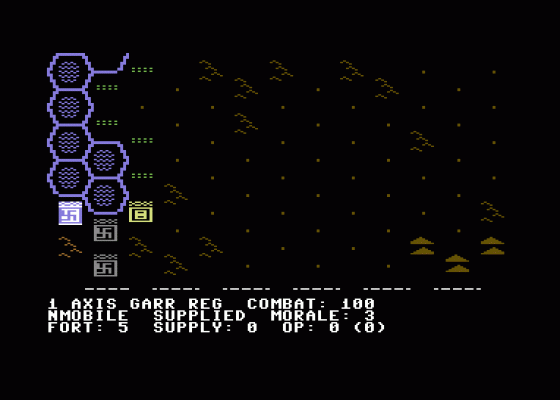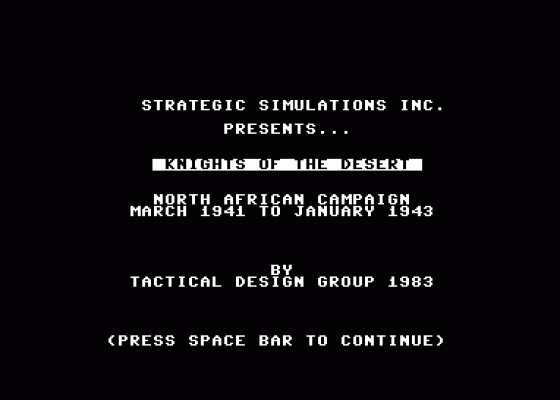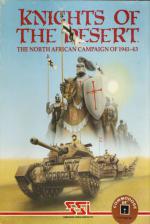
Zzap
 1st June 1986
1st June 1986
Categories: Review: Software
Publisher: Strategic Simulations Inc
Machine: Commodore 64
Published in Zzap #14
Knights Of The Desert
This game, like Tigers in the Snow reviewed last issue, was first released some time ago but has only just been reincarnated in the Transatlantic Simulations format. The game comes packaged in a slim disk folder that contains a fold-out rules sheet and the game itself. The game, as its title suggests, concentrates on the North African campaign in World War II. Although there are solitaire and two- player options, you are restricted to playing axis forces during solo games.
The system uses true hexagonal movement, with all actions by either side taking place in a series of clearly defined segments, each of which are further divided into the required number of phases. SSI pay a great deal of attention to the most successful board game formats and this game is typical of their 'traditional' approach in game mechanics. Units are given standard identification markers and range in size from Corps to Regiment. Supply for the units on both sides is dealt with by a series of depots available to specific forces. Depots may be captured during the course of the game.
The rules are fairly complex, not so much in terms of too many rules, but the implications of the rules themselves. Movement, supply, morale and various other factors have been considered in great depth and the status of individual units can have a far reaching effect as a result. One thing is for certain, Knights of the Desert is not a game for the inexperienced (unless they have particular patience). A game could be played after just a few minutes of reading through the rules, but many of the effects would not he understood by any player who was not very experienced.

There are six scenarios and each uses SSI's predictably complex, but authentic, victory point system. Again, following the example set with previous SSI games, the player is provided with an order of battle listing along with charts for combat losses, air losses, combat risks (loss modifiers), defender odds, combat operation chart, morale modifiers, unit cadre table and an airpower table. Not that any of these are essential to play (though they can suggest strategies by themselves), but SSI's attitude towards the people who play their games is an extremely healthy one. By providing the tables, they allow dissection and examination of their own game design philosophy. A pleasing addition that would be welcome from other manufacturers.
Although the game is hex based, it would not have been prohibitive to include a joystick handling routine. The use of the keyboard to the exclusion of any other input devices makes play slower than perhaps it should have been. Also, while there are plenty of rules, they are a little unfriendly, and when reading through them, I had the feeling that SSI expected to be dealing with a converted audience and therefore ignored the beginner who may be struggling to get to grips with the concept of wargaming. This shows just a slight hint of elitism which isn't really necessary.
Play proceeds at a rather slow pace throughout, and this is mainly due to the attention to detail from the rules system. It appears to be accurate and that is never something to be underestimated (though there are complexity levels and optional rules). But one of the best parts of the game lies in the packaging. The fold out rules booklet contains an historical essay called 'Brazen Knights and Blazing Sands' which, despite the dodgy title and a pretentious (and dare say it, warped) introduction, turns out to be a fascinating account of the North African campaign from the successful, but unsung, heroes of Wavell and O'Conner who hammered out a crushing defeat to the Italians for the bungling but popular Montgomery. Throughout most of this time Rommel, of course, gets a fair amount of attention.

To anybody concerned with the historical context of the game, the notes provide a coherent and essential reference work. Not many computer war gamers have a vast library of military history, and fewer still would be aware of some of the circumstances surrounding the campaign. In contrast to the rules, the historical notes provide an entertaining backdrop which, despite the necessary brevity and the fact that the campaign covered many engagements over a couple of years, remains highly informative.
Really though, the game has little new to offer and US Gold themselves have now released enough games to provide reasonable alternatives - many of which are superior. PSS are almost ready to release their own more limited but attractively simplified Tobruk and CCS may be converting their superlative Spectrum wargame, Desert Rats. Experienced gamers with an interest in the period should find everything they could want in a simulation of the era from Knights of the Desert. For everyone else, I would recommend other choices before buying this game. It puts a lot of demands on the player and gameplay and aesthetics are beginning to show their age. However, it remains a challenging and authentic game of the period, and for the price it is very reasonable.
Verdict
Presentation 76%
The fine printing makes the instructions and notes less fun to read and the screen display is a little above average.
Graphics 80%
Good use of unit markers and legible display.
Instructions 65%
Everything's there, but with very few explanations of the concepts used. The historical notes are better.
Authenticity 86%
Despite the poor presentation, the mechanics seem to be well designed.
Playability 70%
Not for the uninitiated.
Value For Money 77%
Is authenticity worth the lack of playability?
Overall 79%
Yes, if you're the patient type.
Other Reviews Of Knights Of The Desert For The Commodore 64
Tigers In The Snow/Knights Of The Desert (Strategic Simulations Inc.)
A review



